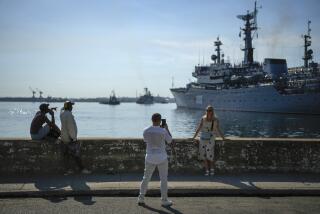Near Disaster in ’62 Missile Crisis Comes to Light
- Share via
HAVANA — Key figures in the 1962 Cuban missile crisis meeting here Saturday have learned that events 40 years ago nearly spun out of control and brought them closer to nuclear disaster than they had imagined.
Studying newly declassified documents at a conference on the crisis, Cuban, American and Russian protagonists were told that the most dangerous day was Oct. 27, 1962 -- when a U.S. Navy destroyer dropping depth charges off the Cuban coast accidentally almost hit the hull of a Soviet submarine that was carrying a nuclear warhead.
The U.S. military “did not have a clue that the submarine had a nuclear weapon on board,” Thomas Blanton, director of the National Security Archives, told reporters Friday night.
The nonprofit archive at George Washington University collected many of the documents for study during the three-day conference on the crisis. The meeting started Friday.
The depth charges “exploded right next to the hull,” Vadim Orlov, the submarine’s signals intelligence officer, said in a written account of the incident. “It felt like you were sitting in a metal barrel, which somebody is constantly blasting with a sledgehammer.”
At first, submarine crew members considered using the nuclear weapon, thinking that war had erupted, Orlov wrote. But they ultimately surfaced, showing themselves to the Americans and defusing the tension.
Another document showed that U.S. intelligence officials had photographed only 33 of the 42 medium-range missiles in Cuba that the Americans later discovered were there at the time.
Intelligence officials also never found any nuclear warheads, which they later learned had been kept on the island.
The historic papers underscored the danger of a nuclear attack -- either accidental or deliberate -- that existed during those tense days.
Anatoly Dobrynin, former Soviet ambassador to the United States, quoted then-U.S. Atty. Gen. Robert F. Kennedy as telling him in a top-secret memo, now declassified, on Oct. 27, 1962, that a war could begin “in which millions of Americans and Russians will die.”
Cuban President Fidel Castro participated in the conference’s closed sessions Friday and Saturday, as did former Defense Secretary Robert S. McNamara.
Later, the former rivals said goodbye with a warm handshake as McNamara left Havana calling for an end to “the risk of destruction of nations by nuclear weapons.”
“That risk is unacceptable today,” he said. The missile crisis began in mid-October 1962 when President Kennedy learned that Cuba had Soviet nuclear missiles capable of reaching the United States. The crisis was defused two weeks later when the Soviet Union agreed to remove the missiles.
More to Read
Sign up for Essential California
The most important California stories and recommendations in your inbox every morning.
You may occasionally receive promotional content from the Los Angeles Times.













